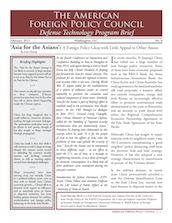On January 29th, 2015, the American Foreign Policy Council (AFPC) invited a panel of China experts to speak on the topic, “Asia for Asians” at the Capital Visitor’s Complex in Washington, DC. As part of the larger Defense Technology Briefing Series designed to educate congressional staff on current events and politics, the panel commented on China’s recent “Asia for Asians” policy and its significance in the greater context of Sino-American and East Asian affairs.
Dr. Joshua Eisenman (AFPC) moderated the panel, and the discussants were Dr. Scott Harold (RAND Corporation), Dr. Abraham Denmark (The National Bureau of Asian Research), and Mr. Randy Schriver (Project 2049 Institute).
Brief History of “Asia for Asians”
In his opening remarks, Dr. Joshua Eisenman introduced the phrase “Asia for Asians” and traced its history, noting that the concept is not a new one but dates back to Imperialist Japan in World War II, when the Japanese first used the term to advocate for a Japanese-led security architecture. More recently, “Asia for Asians” was reintroduced at the 10th anniversary of the Shangri-La dialogue in June 2011 by then-Chinese National Defense Minister General Liang Guanglie. This position was further clarified early in 2014: first at the Fourth Summit of the Conference on Interaction and Confidence Building Measures in Asia, and then in South Korea, where Xi first mentioned, “Asia for Asians”. The concept was then formally introduced to foreign guests at the Xiangshan Forum from November 20-22, 2014 in Beijing.
Panelists’ Remarks
In his comments, Dr. Scott Harold highlighted the growing number of new security initiatives in recent years that suggest China is moving away from the non-confrontational, “low posture” foreign policies of the 1980s and 1990s and towards a more active approach designed to shape the world and the region by establishing organizations and institutions where Chinese influence is predominant. Among other trends, the heightened territorial disputes with India, Japan, the Philippines, and Vietnam, the establishment of the ADIZ, the South China Sea island building, and the efforts to build a suite of military capabilities that will discourage US forces from operating in East Asia suggest an assertive approach by China in tackling regional issues. In this context, the “Asia for Asians” initiative is unlikely to be successful, in part because the concept aligns more with an “Asia for China.” It may be the case that part of the idea’s significance lies in its domestic implications, where Xi Jinping is consolidating power. “Asia for Asians” portrays President Xi as a strong and secure domestic leader, and can be seen as an attempt to inoculate himself from criticism by factional rivals.
The subsequent discussion revolved around the implications of “Asia for Asians” in a larger regional context. Dr. Abraham Denmark described the policy as reflecting China’s aspirations to carve out a leading role in East Asia. At the same time, he noted that China’s concept of alliances as coercive structures is self-limiting. Soft power efforts to present China as a benevolent actor have been unfruitful, and the PRC’s increased economic activities in East Asia do not pose a direct threat to U.S. influence. The United States remains the only force that can keep itself out of Asia. Thus, the ongoing negotiations surrounding the Trans-Pacific Partnership are especially important. The regional multinational trade agreement would establish higher standards of trade and potentially ensnare China in responsible multilateral negotiations.
Mr. Schriver echoed Mr. Denmark in dismissing “Asia for Asians” as recycled rhetoric. Instead, he said, the term represents a stronger push to establish Chinese regional influence. Since the 2008 financial crisis, the perception of the United States in China has been one of decline, which has presented a “window of opportunity” for a more aggressive Chinese foreign policy. In response, he said, the United States should reorient its approach through partnership and alliance building, while underscoring its position as a Pacific country with strategic interests in the region. In the greater picture, “Asia for Asians” is just another element in the foundation of US-China strategic competition.
To access the paper based on the speakers' comments, please read the downloadable file below.


